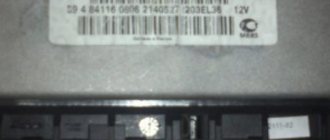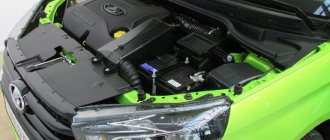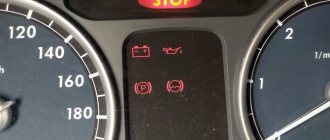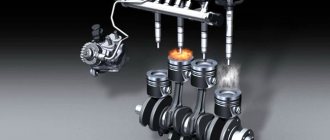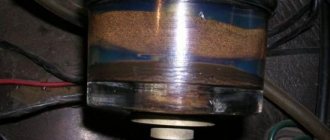We will talk about the sore point and, so to speak, about the budgetary increase in power. As you know, 70% (pelvis drivers) push the camshaft into themselves and complain about the dynamics of the car. Why did the idle disappear and the car became dumber during acceleration (when he set the roller with a phase above 270). The answer is simple, gentlemen: your shaft is not unable to work at the bottom, it works at the top. Yes, this is a very necessary thing, but for combat vehicles operating mainly at high speeds.
For an everyday car, the city mode on such a shaft will be the most severe torment, idle is about 1200-1400 rpm, respectively, you start at almost 2000 rpm, burn the clutch and, accordingly, load the standard parts of the unit, which are not designed for such a load. In the summer, the temperature in the car constantly rises and the car often boils, and it’s good if everything gets by with just a loss of antifreeze. By inserting a part without a special understanding of the characteristics of the camshaft, we can lose not only money, but also possibly end up on the capital of the cylinder head. But we will try to avoid this with you, choose the optimal shaft that really suits your riding style. But. Remember. When installing this or that shaft, you lose something. For example, let’s consider the Nuzhdin 10.93 shaft, which is very well known to you. (Please note that I once went to an online store, looked at this shaft with a phase of 282° and in it it was in the lower section (8-valve engine), although if you know a little about the camshaft, then with a phase wider than 270° it is considered upper. How? It will remain a mystery.) Therefore, it is still worth knowing what you are taking. So, let's continue. Most people install it, and its operating range is not from 2000 rpm to 5000, its range is much higher, it begins to work intensively from 3000 to 6500 rpm. In principle, it is not bad at low end, but a smoother idle speed can be achieved around 1300 rpm. Although some manage to set it to 1100 rpm. The valve travel is quite significant - 2.1 mm; if the valve belt breaks, it will definitely bend (if the engine is 1.5). So, let's try to choose the optimal camshaft for you. For city driving, as everyone knows, you need smooth idle and traction from below (increasing engine displacement will also add traction from below, but that’s another story). Let's consider them: there are three types: ➤ grassroots ➤ instant ➤ horse
What and why are there camshafts?
And there would never be a conversation about how to choose a camshaft if all drivers were limited to what they had on the car from the assembly line - a standard engine with standard power ratings.
But, after all, drivers are people too, which means that each of us has our own character, and wants to drive a car in accordance with the main traits of our character. Someone calmly and without unnecessary fuss on the road. And give someone a drive, a sharp move forward at a traffic light, the wind in their face on the highway.
Actually, this is where the need for engine tuning arises, one of the main factors of which is replacing the standard camshaft with a sports camshaft. And very often “hot” guys ask the question of how to choose a camshaft from the mass of offers on today’s market of spare parts for car repair and tuning.
And if imported cars have quite powerful engines, then in the vastness of our country they are most often looking for a sports camshaft for the classics. Sometimes even not for special drive, but to improve engine performance.
After all, replacing a camshaft essentially shapes the nature of your engine’s operation, determining the lift speed and duration of valve opening.
Typically, the camshaft is located at the top of the cylinder head. It is today. Previously, engines used the so-called bottom camshaft. The number of camshafts depends on the number of engine cylinders and the number of engine cylinders.
Why is there such a demand for a sport camshaft? The answer is simple. They provide the most optimal supply of air-fuel mixture charge to the cylinders by increasing the valve lift height.
The smoothness of the cam profile of the camshaft tuning ensures the most reliable operation of the timing belt. In addition, the sports camshaft has a characteristic feature - it increases the detonation limit. That is, this is a movement without the characteristic “knock of fingers”, so familiar to drivers of classic domestic car models.
Let's start with the intake.
The most obvious relationship is the connection between the duration of opening of the intake valve and the filling of the cylinder with the working mixture. As the intake duration increases, more working mixture enters the cylinder, but this has limits. Since the intake phase exceeds 180 degrees, the intake valve will open slightly earlier than the piston passes TDC and close slightly later than BDC. Increasing the intake phase will lead to an increase in these advances/lags.
Tuning Ford Fiesta - sweet berry
When the piston passes BDC, a small vacuum still remains in the cylinder, which continues to draw in the working mixture, so some delay in closing the intake valve is justified, but later the piston begins the process of actively compressing the working mixture and, if the valve has not yet closed, pushes part of the mixture back. If the valve opening is significantly advanced, some of the exhaust gases pushed out of the cylinder by the piston may leak through the intake valve and deplete the incoming working mixture. This is typical for engine operation at low speeds.
And here is a sports camshaft
Why do we need a camshaft, and even a sports type? It turns out that everything is very simple and logical. After all, the graphical indicator of torque (curve) directly depends on the gas distribution parameters. They are also called “valve timing”. Which imply the time and amount of opening of the valves in the engine. And as you know, from the engine design, these values depend on the profile of the camshaft cams and their angle of rotation. In this regard, most production cars have a certain average valve timing. Since the common man needs that in lower gears the car can move off confidently, and when driving at medium and high speeds, fuel consumption and engine response are effective.
The camshaft affects the entire operation of the engine
Those who do not see themselves outside of a high-speed and dynamic car simply need to replace the standard camshaft with another tuned one. They are often called sports.
Valve overlap
Valve overlap is the moment when the intake valve and exhaust valve are simultaneously open, that is, the exhaust valve has not yet closed, but the intake valve has already opened. The piston is at TDC at this moment. The simultaneous opening of the valves is necessary for the so-called cylinder purging, when the exhaust gases carry the working mixture with them through the intake valve. (by the way, a tuned exhaust manifold or “spider” can help us here) The amount of overlap is expressed in mm (in a standard timing belt, the overlap is almost 0)
"STI" CAMSHAFTS
Sports Technologies and Engineering (popularly known as “Zakievskie”)
Archival information
| № | Designation | Valve lift | Open/camber phase width | when rising. profile | valve clearance | Washer Disc Valve Springs | Pusher (lever) | Note | |
| Engines 1.5…1.8 l., Inter-cylinder distance AC=89 mm., 2 valves per cylinder | |||||||||
| 1 | 2111 STI-01 | Inlet | 10,7 | 266/109 | 0,2 | 0,15 – 0,2 | Serial | Serial | Increased torque at 1200…5000 rpm with a slight increase in power |
| Release | 10,7 | 266/113 | 0,2 | 0,25 – 0,3 | |||||
| 2 | 2111 STI‑1 | Inlet | 11,0 | 272/109 | 0,2 | 0,15 – 0,2 | Serial | Serial | Increased torque at 1500…5600 rpm with a slight increase in power |
| Release | 10,7 | 266/113 | 0,2 | 0,25 – 0,3 | |||||
| 3 | 2111 STI-1.1 | Inlet | 11,2 | 270/109 | 0,2 | 0,15 – 0,2 | Serial | Serial | Increased torque at 1500…6000 rpm. |
| Release | 11,2 | 270/113 | 0,2 | 0,25 – 0,3 | |||||
| 4 | 2111 STI-2 | Inlet | 11.2 | 280/107 | 0,2 | 0,15 – 0,2 | Serial | Serial | Increased torque at 3500…6500 rpm. Characteristic sports exhaust. |
| Release | 11.2 | 280/111 | 0,2 | 0,25 – 0,3 | |||||
| 5 | 2111 STI-2.1 | Inlet | 11,4 | 280/114 | 0,2 | 0,15 – 0,2 | Serial | Serial | Increased torque at 3500…6500 rpm. |
| Release | 11,4 | 280/114 | 0,2 | 0,25 – 03 | |||||
| 6 | 2111 STI-3 | Inlet | 11,7 | 288/111 | 0,2 | 0,15 – 0,2 | Serial* | Serial | Increased power. *Sometimes modification of the cylinder head is required |
| Release | 11,7 | 280/110 | 0,2 | 0,25 – 03 | |||||
| 7 | 2111 STI-4 | Inlet | 12,1 | 308/111 | 0,2 | 0,15 – 0,2 | Serial* | Serial | “Road sport” *cylinder head modification required |
| Release | 12,1 | 300/110 | 0,2 | 0,25 – 03 | |||||
| 8 | 2111 Sport‑1 | Inlet | 13,2 | 296/107 | 0,2 | 0,18 – 02 | 013 02 064 013 02 031 | Original | Sports "rally/cross". Shrick springs, original. plates, washers, pushers |
| Release | 12,5 | 296/109 | 0,2 | 0,28 – 0,3 | |||||
| 9 | 2111 Sport‑2 | Inlet | 13,2 | 304/104 | 0,2 | 0,18 – 0,2 | 013 02 064 013 02 031 | Original | Sports "ring/racetrack". Shrick springs, original. plates, washers, pushers |
| Release | 13,2 | 296/111 | 0,2 | 0,28 – 0,3 | |||||
| 10 | 2111 Sport‑3 | Inlet | 13,5 | 310/110 | 0,2 | 0,18 – 0,2 | 013 02 064 013 02 031 | Original | Sports "ring/racetrack". Shrick springs, original. plates, washers, pushers |
| Release | 13,2 | 304/109 | 0,2 | 0,28 – 0,3 | |||||
| Engines 1.5…1.8 l., Inter-cylinder distance AC=89 mm., 4 valves per cylinder | |||||||||
| 11 | 2112 STI‑1 | Inlet | 8,8 | 271/104 | 0 | Hydraulic compensator | serial | serial | Increase in torque at 1600…6500 rpm with a slight increase in power (~10%) |
| Release | 8,8 | 271/110 | 0 | ||||||
| 12 | 2112 STI-2 | Inlet | 8,8 | 291/111 | 0 | Hydraulic compensator | serial | serial | Cup-Lada improved Increased power at 4700…7400 rpm. |
| Release | 8,8 | 291/111 | 0 | ||||||
| 13 | 2112 STI-3 | Inlet | 9,8 | 281/114 | 0 | Hydraulic compensator | serial* | serial | Increased power without degrading torque. *cylinder head modification required |
| Release | 9,8 | 281/106 | 0 | ||||||
| 14 | 2112 STI‑3.1 | Inlet | 9,1 | 281/114 | 0 | Hydraulic compensator | serial* | serial | Increased power and torque at 1600…6500 rpm. |
| Release | 9,1 | 281/106 | 0 | ||||||
| 15 | 2112 STI-4 | Inlet | 10,4 | 295/110 | 0 | Hydraulic compensator | serial* | serial | Increased power and torque. *cylinder head modification required |
| Release | 10,4 | 295/110 | 0 | ||||||
| 16 | 2112 STI‑4.1 | Inlet | 9,82 | 295/110 | 0 | Hydraulic compensator | serial* | serial | Increased power and torque. *cylinder head modification required |
| Release | 9,82 | 295/110 | 0 | ||||||
| 17 | 2112 STI-5 | Inlet | 10,7 | 303/111 | 0 | Hydraulic compensator | serial* | serial | Increased power above 5500 rpm. *cylinder head modification required |
| Release | 10,7 | 303/111 | 0 | ||||||
| 18 | 2112 STI-5.1 | Inlet | 9,1 | 300/111 | 0 | Hydraulic compensator | serial* | serial | Increased power above 5600 rpm. *cylinder head modification required |
| Release | 9,1 | 300/111 | 0 | ||||||
| 19 | 2112 STI-6 | Inlet | 11,1 | 310/111 | 0 | Hydraulic compensator | serial* | serial | “Road sport” *cylinder head modification required |
| Release | 10,7 | 300/111 | 0 | ||||||
| 20 | 2112 Sport‑1 | Inlet | 10,6 | 296/110 | 0,2 | 0,18 – 0,2 | serial* | Original mechanical 30 mm. | Sports "rally/cross" orig. plates, washers, pushers |
| Release | 10,6 | 288/110 | 0,2 | 0,28 – 0,3 | |||||
| 21 | 2112 Sport‑2 | Inlet | 10,6 | 304/110 | 0,2 | 0,18 – 0,2 | serial | Original mechanical 30 mm. | Sports "rally" orig. plates, washers, pushers |
| Release | 10,6 | 296/110 | 0,2 | 0,28 – 0,3 | |||||
| 22 | 2112 Sport‑2.1 | Inlet | 11,0 | 304/110 | 0,2 | 0,18 – 0,2 | serial | Original mechanical 30 mm. | Sports "rally" orig. plates, washers, pushers |
| Release | 11,0 | 300/110 | 0,2 | 0,28 – 0,3 | |||||
| 23 | 2112 Sport‑3 | Inlet | 10,6 | 312/110 | 0,2 | 0,18 – 0,2 | Serial from Opel C20XE | Original mechanical 30 mm. | Sports "ring/racetrack" orig. plates, washers, pushers |
| Release | 10,6 | 304/110 | 0,2 | 0,28 – 0,3 | |||||
| 24 | 2112 Sport‑3.1 | Inlet | 11,0 | 312/110 | 0,2 | 0,18 – 0,2 | Serial from Opel C20XE | Original mechanical 30 mm. | Sports "ring/racetrack" orig. plates, washers, pushers |
| Release | 11,0 | 304/110 | 0,2 | 0,28 – 0,3 | |||||
| 25 | 2112 Sport‑3.2 | Inlet | 11,0 | 320/110 | 0,2 | 0,18 – 0,2 | Serial from Opel C20XE | Original mechanical 30 mm. | Sports "ring/racetrack" orig. plates, washers, pushers |
| Release | 11,0 | 312/110 | 0,2 | 0,28 – 0,3 | |||||
| 26 | 2112 Sport‑4 | Inlet | 12,3 | 304/103 | 0,2 | 0,18 – 0,2 | Serial from Opel C20XE | Original mechanical 31 mm. | Sports "rally" orig. plates, washers, pushers |
| Release | 12,3 | 297/103 | 0,2 | 0,28 – 0,3 | |||||
| 27 | 2112 Sport‑5 | Inlet | 12,3 | 310/107 | 0,2 | 0,18 – 0,2 | Serial from Opel C20XE | Original mechanical 31 mm. | Sports "ring" orig. plates, washers, pushers |
| Release | 12,3 | 304/107 | 0,2 | 0,28 – 0,3 | |||||
| 28 | 2112 Sport‑6 | Inlet | 12,3 | 316/107 | 0,2 | 0,18 – 0,2 | Serial from Opel C20XE | Original mechanical 31 mm. | Sports "ring" orig. plates, washers, pushers |
| Release | 12,3 | 304/107 | 0,2 | 0,28 – 0,3 | |||||
| 29 | 2112 Sport‑7 | Inlet | 12,3 | 324/108 | 0,2 | 0,18 – 0,2 | Serial from Opel C20XE | Original mechanical 31 mm. | Sports "ring" orig. plates, washers, pushers |
| Release | 12,3 | 316/108 | 0,2 | 0,28 – 0,3 | |||||
| 30 | 2112 Sport‑7.1 | Inlet | 13,2 | 324/108 | 0,2 | 0,18 – 0,2 | Serial from Opel C20XE | Original mechanical 31 mm. | Sports "ring" orig. plates, washers, pushers |
| Release | 12,3 | 324/108 | 0,2 | 0,28 – 0,3 | |||||
| 31 | 2112 Sport‑8 | Inlet | 13,2 | 330/108 | 0,2 | 0,18 – 0,2 | Serial from Opel C20XE | Original mechanical 31 mm. | Sports "ring" orig. plates, washers, pushers |
| Release | 13,2 | 324/108 | 0,2 | 0,28 – 0,3 | |||||
| 32 | 2112 Sport-9.1 | Inlet | 12,3 | 308/110 | 0,2 | 0,18 – 0,2 | Serial from Opel C20XE | Original mechanical 31 mm. | Sports ring/racetrack/rally, original plates, washers, pushers |
| Release | 12,1 | 302/110 | 0,2 | 0,28 – 0,3 | |||||
| 33 | 2112 Sport-9.2 | Inlet | 12,3 | 314/110 | 0,2 | 0,18 – 0,2 | Serial from Opel C20XE | Original mechanical 31 mm. | Sports "ring" orig. plates, washers, pushers, dor. cylinder head |
| Release | 12,3 | 308/100 | 0,2 | 0,28 – 0,3 | |||||
| Engines 1.5…1.8 l., Inter-cylinder distance AC=95 mm., 2 valves per cylinder | |||||||||
| 34 | 2121 STI‑1 | Inlet | 10,7(6,9) | 266/105 | 0,2 | 0,23(0,15) | serial | serial | Increase in torque 1200..5000 rpm, with a slight (~7%) increase in power |
| Release | 10,7(6,9) | 266/113 | 0,2 | 0,23(0,15) | |||||
| 35 | 2121 STI-2 | Inlet | 11,2(7,2) | 280/107 | 0,2 | 0,23(0,15) | serial | serial | Increased power without deteriorating torque at 1500..6000 rpm. |
| Release | 11,2(7,2) | 280/109 | 0,2 | 0,23(0,15) | |||||
| 36 | 2121 STI-3 | Inlet | 11,7(7,5) | 293/113 | 0,2 | 0,23(0,15) | serial | serial | "Road sport". Increased power and torque at 3000…6500 rpm. |
| Release | 11,5(7,3) | 285/111 | 0,2 | 0,23(0,15) | |||||
| 37 | 2121 STI-4 | Inlet | 12,1(7,7) | 309/112 | 0,2 | 0,23(0,15) | serial | serial | "Road sport". Increased power and torque at 3500…6800 rpm. |
| Release | 12,0(7,65) | 301/112 | 0,2 | 0,23(0,15) | |||||
| 38 | 2123 STI-1 | Inlet | 11,2(7,2) | 283/107 | 0 | Hydraulic compensator | serial | serial | Increase in torque 1500..6000 rpm, with a small (~10%) increase in power |
| Release | 11,2(7,2) | 276/109 | 0 | ||||||
| 39 | 2123 STI-2 | Inlet | 11,2(7,2) | 292/107 | 0 | Hydraulic compensator | serial | serial | Increased power and torque at 1800..6200 rpm. |
| Release | 11,2(7,2) | 292/109 | 0 | ||||||
The cam camber is specified depending on the engine displacement and the configuration of the intake and exhaust systems.
You can purchase, install, configure these radios (and much more) at the official representative office in Moscow.
Recommendations from Sports Technologies and Engineering on the selection of shafts.
The cheapest and most effective way to change the traction and dynamic properties of your car is to replace the camshaft with or without appropriate correction of the ECM control program. The main geometric characteristics of the range of proposed camshafts - valve lift and opening phase width - are given in the table.
How to choose the most suitable camshaft for you from this table!?
If you like a smooth ride rather than a dynamic one, if frequent gear changes bring you more inconvenience than pleasure, and, finally, if safe driving on roads with poor surfaces (snow, ice, water, mud) at low speeds is more important to you than dynamics during acceleration, then shafts with a narrow valve opening phase, which are sometimes also called “torque”, are more suitable for you:
2111-STI-1; 2112-STI-1; 2121-STI-1.
They will increase the power of your engine in the lower speed zone - 1500...3000 rpm and make driving comfortable and smooth throughout the entire operating range of the engine. It will be possible to switch to a lower gear when the engine “no longer pulls” much less often. STI camshafts for easy tuning are designed in such a way that they do not require replacement or special modifications of other engine parts, such as camshaft pulleys and cylinder heads. You just need to replace the camshaft(s) and adjust the clearances if you don't have hydraulic tappets. All adjustments and installation are according to the original VAZ instructions. The effect will be more complete if you rewrite the ECM control program with the “STI” program specially developed for this camshaft.
If you like dynamic driving with frequent and sharp accelerations, driving at maximum speeds outside the city and at the same time more frequent gear changes do not bother you or, on the contrary, bring pleasure, then shafts with a “medium” and “wide” valve opening phase are suitable for you, which are sometimes called “power”:
2111-STI-2; 2111-STI-3; 2112-STI-2; 2112-STI-3; 2112-STI-4; 2121-STI-2.
When choosing a “power” camshaft, you must also keep the following in mind. Camshafts of the STI-3 type increase the maximum engine power more than STI-2, and STI-4 shafts increase the power more than STI-3. At the same time, the engine speed at which this higher maximum power is achieved increases accordingly. Camshafts with a “medium” width of the valve opening phase of the “STI-2” type, as well as “narrow” ones, do not require any replacement of other parts or special modifications. Therefore, this can be called the simplest and cheapest power option. But at the same time, it is also recommended to change the ECM control program to the “STI” program developed specifically for this shaft. Camshafts with a “wide” valve opening phase of the “STI-3” type also do not require replacement of other engine parts. But before installing them, minor modifications to the cylinder head will be required, which we recommend to perform only in tuning workshops that have the appropriate experience. Replacing the ECM control program is not only recommended here, it is necessary. 2112-STI-4 camshafts have the largest valve opening width of all tuning (non-sports) options. All other parts here also remain standard, but the cylinder head will require slightly more modification. It should also be borne in mind that if with camshafts of the “STI-2” and “STI-3” types the power increases in the upper engine speed zone (4000...6500 rpm) and at the same time the engine parameters do not deteriorate in the lower speed zone (1500 ...3000 rpm), then in the case of shafts of the “STI-4” type you get a “quasi-sports” option. That is, your engine will easily spin up to 7000...7200 rpm, have the highest maximum power of all tuning options, but in the lower speed zone it will have reduced performance. This option is for people who prefer a clearly expressed “STI”.
Part types
Camshafts on the VAZ 2114 are divided into types according to different criteria: condition, manufacturer, configuration, design features, etc.
Camshafts are classified according to their location:
- With a lower location.
- Top positioned.
The camshaft can be:
- Ordinary.
- Tuningov.
- Sports.
There are camshafts for VAZ 2114 on:
- Eight valve engines.
- Sixteen-valve engines.
According to the configuration, you can buy a camshaft:
- No additional elements.
- Complete with adjustment bolts and rockers.
The manufacturer's detail may be:
- Original.
- Unoriginal.
According to the condition, you can take the camshaft:
- New.
- boo.
At the place of purchase, the spare part is:
- Bought at a car market.
- Purchased from a specialty store.
- Taken from a private advertisement.
- Bought at a car wrecker.
- Ordered from the online store.
You can buy a camshaft of this brand:
- AvtoVAZ.
- Needs.
- Stolnikov.
- ZMZ.
- USA.
- Premier.
According to the payment method, a purchase can be made:
- On credit.
- In installments.
- Through personal financial savings.
What's the result?
Having examined the problem of installing a sports camshaft from several angles, we can draw the following conclusions:
The choice of camshaft primarily depends on which driving mode you need more. If it's sharp acceleration dynamics at low speeds, then a low-level camshaft with a smooth cam profile is your best friend.
If speed and speed on the track are your thing, then you will need an overhead camshaft with its sharper cams.
“Upper” and “lower” shafts - what is their operating principle and what is it?
Conventionally, tuning camshafts come in low and high camshafts. It has already been said above that the camshaft is the “brain” of the engine. It is this that determines the speed of rise and the phases are made as wide as possible, which basically determines the performance of the unit. The basis for replacing a standard camshaft with a sports one is the same as replacing other components. The original part is too average and was developed based on mass consumer demand. Motor performance depends on power. In fact, the character of a vehicle is influenced not only by high power, but also by torque, because maximum power in a conventional car can only be achieved with similar values. A driver who respects speed needs a fast engine that follows the accelerator pedal when it takes off. This provides torque, if it is quite large and constant at low and medium speeds. VAZ engines, in the opinion of rally drivers, have a big drawback. They do not have enough traction when turning the crankshaft at low speeds. Until the unit reaches 3000 rpm, it jerks at start and failures occur when the accelerator is sharply pressed. To improve throttle response, you should change the valve opening/closing time. The mechanical brain ensures an acceptable supply of the fuel mixture to the cylinder by the height of the intake valves. The smooth profile of the camshaft cams reliably protects the timing belt. The peculiarity of sports camshafts is that they push back the detonation limit at low frequencies.
Characteristics of auto parts
The camshaft is an element of the gas distribution mechanism . He is responsible for the timely opening and closing of the fuel supply valve. It has the form of a cast iron rod on which there are cams and support journals for installation in the motor housing. An oil valve is also part of the part.
Signs of a faulty camshaft:
- The appearance of a knock in the area where the mechanism is located.
- Loss of motor power.
- Increased fuel mixture consumption.
- Unstable engine operation.

